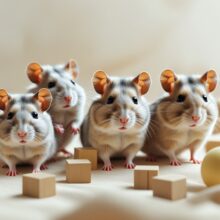Social Structure and Interaction in Gerbils

Social Structure and Interaction in Gerbils: Understanding Their Social Dynamics
Gerbils are highly social creatures that thrive on interaction with their fellow gerbils. Their social structure and behavior are fascinating and complex, reflecting their natural instincts and environmental adaptations. Understanding the social structure and interaction in gerbils is essential for providing appropriate care and creating a stimulating environment that meets their social needs. This comprehensive guide will explore the key aspects of gerbil social behavior, including their social hierarchy, communication methods, bonding, and tips for managing social interactions.
Social Structure in Gerbils
In the wild, gerbils live in colonies with a well-defined social structure. This social organization is crucial for their survival, as it helps them manage resources, protect against predators, and maintain group cohesion.
Hierarchical Structure
Gerbil colonies have a hierarchical structure, with dominant and subordinate individuals. This hierarchy is established through various social behaviors and interactions.
- Dominant Gerbil: The dominant gerbil, often an older or stronger individual, asserts its position through displays of dominance and control over resources such as food and nesting sites. Dominant gerbils may engage in grooming and mounting behaviors to reinforce their status.
- Subordinate Gerbils: Subordinate gerbils recognize and submit to the dominant gerbil’s authority. They may exhibit submissive behaviors such as grooming the dominant gerbil or avoiding direct confrontation.
Living in Pairs or Groups
Gerbils should always be kept in pairs or small groups to prevent loneliness and stress. Keeping gerbils alone can lead to behavioral issues and negatively impact their well-being.
Benefits of Social Living
- Reduced Stress: Social interactions help reduce stress and anxiety in gerbils. Being in the presence of other gerbils provides comfort and security.
- Enhanced Activity: Gerbils kept in pairs or groups are more active and playful. Social interactions encourage natural behaviors such as grooming, playing, and exploring.
- Mental Stimulation: Social living provides mental stimulation, preventing boredom and promoting cognitive development.
Same-Gender Pairs
To avoid breeding, it is advisable to keep gerbils in same-gender pairs. Male gerbils (bucks) and female gerbils (does) can both form strong bonds with their cage mates. When introducing new gerbils, ensure they are the same gender to prevent unexpected litters.
Communication Methods
Gerbils communicate with each other through a combination of vocalizations, body language, and scent marking. Understanding these communication methods helps in interpreting their behavior and needs.
Vocalizations
Gerbils produce a range of sounds to convey different messages. Some common vocalizations include:
- Chirping: A soft, high-pitched sound often heard during play or grooming. It indicates contentment and social bonding.
- Thumping: Rapid thumping of the hind legs against the ground is a warning signal. Gerbils thump to alert others of potential danger or to assert dominance.
- Squeaking: A louder, higher-pitched sound that can indicate excitement, distress, or displeasure. Monitor the context to determine the cause.
Body Language
Observing gerbil body language provides valuable insights into their emotional state and intentions:
- Grooming: Gerbils groom themselves and each other to maintain hygiene and social bonds. Frequent grooming indicates a healthy and well-adjusted gerbil.
- Standing Upright: When a gerbil stands on its hind legs, it is usually surveying its surroundings or investigating a new object. This behavior reflects curiosity and vigilance.
- Digging and Burrowing: Digging is a natural behavior that allows gerbils to create tunnels and burrows. It is essential to provide deep bedding to satisfy this instinct.
- Tail Posture: A relaxed, low-hanging tail indicates a calm and content gerbil. A raised or twitching tail may signal alertness or agitation.
Scent Marking
Gerbils use scent marking to establish territory and communicate with other gerbils. They have scent glands on their bellies, which they rub against objects to leave their scent.
- Territorial Marking: Scent marking helps gerbils define their territory and reduce conflicts with other gerbils. It is a normal and important behavior in social interactions.
- Identifying Group Members: Gerbils recognize their cage mates by scent. Scent marking reinforces social bonds and helps them identify members of their group.
Bonding and Social Interactions
Bonding and social interactions are essential for maintaining a harmonious gerbil group. Understanding how gerbils bond and interact can help you manage their social dynamics effectively.
Bonding Behaviors
Gerbils form strong bonds with their cage mates through various social behaviors:
- Mutual Grooming: Gerbils groom each other to strengthen social bonds and maintain hygiene. This behavior is a sign of affection and trust.
- Sleeping Together: Gerbils often sleep in piles, huddling together for warmth and comfort. This behavior reinforces their social bonds and provides a sense of security.
- Play: Playful interactions, such as chasing and wrestling, are common among bonded gerbils. These activities help establish social hierarchies and provide mental stimulation.
Managing Social Interactions
Effective management of social interactions is crucial for preventing conflicts and ensuring a peaceful environment:
- Introducing New Gerbils: Introducing new gerbils to an established group requires careful planning. Use the split-cage method, where a cage divider separates the gerbils, allowing them to get used to each other’s scent before direct contact. Gradually remove the divider and monitor their interactions.
- Monitoring for Aggression: Keep a close eye on interactions between gerbils, especially during introductions. Look for signs of stress or tension, such as chasing, biting, or fur pulling. If aggression occurs, separate the gerbils immediately and reintroduce them gradually.
- Providing Enrichment: Ensure the cage has plenty of enrichment items to reduce boredom and minimize conflicts. Tunnels, hideouts, and chew toys can keep gerbils engaged and prevent aggressive behavior.
Understanding and Responding to Gerbil Behavior
Understanding gerbil behavior enhances your relationship with your pets and ensures their well-being. Here are some tips for interpreting and responding to their actions:
Building Trust
Building trust with your gerbils involves gentle handling and regular interaction:
- Start Slowly: Allow your gerbils to get used to your presence before attempting to handle them. Offer treats and speak softly to build trust.
- Gentle Handling: Scoop your gerbil with both hands to provide support and prevent falls. Avoid grabbing or squeezing your gerbil, as this can cause stress.
- Daily Interaction: Spend time with your gerbils daily to strengthen your bond. Play with them using toys and offer gentle petting once they are comfortable with handling.
Addressing Aggression
Aggression between gerbils can occur, especially when introducing new members to a group. Addressing aggression promptly is essential to prevent injuries:
- Separate Aggressive Gerbils: If fights break out, separate the aggressive gerbils immediately to prevent harm. Use a split-cage method to reintroduce them gradually.
- Monitor Interactions: Keep a close eye on interactions between gerbils, especially during introductions. Look for signs of stress or tension and intervene if necessary.
- Provide Enrichment: Ensure the cage has plenty of enrichment items to reduce boredom and minimize conflicts.
Conclusion
Understanding the social structure and interaction in gerbils is key to providing appropriate care and creating a stimulating environment that meets their social needs. By recognizing their social hierarchy, communication methods, bonding behaviors, and managing their social interactions, you can enhance your relationship with your gerbils and ensure their well-being. Gerbils are delightful pets that offer endless entertainment and companionship, and with the right care and understanding, they can thrive and become cherished members of your family.



